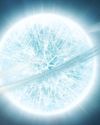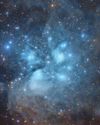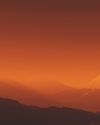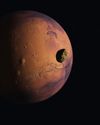WHAT DOES THE FUTURE HOLD FOR THE SOLAR SYSTEM?
All About Space
|Issue 105
It may be a model of long-term stability, but our solar neighbourhood’s future holds some cataclysmic events and spectacular changes

Ever since it settled down from a period of early turbulence about 4 billion years ago, our Solar System has provided a more or less stable home to Earth and the other planets and bodies that orbit the Sun. But how long will it stay that way? It’s certain that the Sun is ultimately doomed to brighten and swell enormously in size, becoming a red giant whose bloated outer atmosphere will threaten to engulf the Solar System’s inner worlds 7 billion years from now – but long before then there are sure to be other changes that alter our planet and others, perhaps beyond recognition.
In the relatively near future, it is tidal forces between planets and their satellites that are likely to have the most impressive effects. These arise as angular momentum is transferred between the planet and moon due to tides on the planet and in response to the moon’s gravity, resulting in a consistent ‘tug’ on the moon’s orbit. For most moons in the Solar System the result is that the satellite slowly spirals away from the planet, while the planet slows its rotation. This is what is happening in our own planetary system – the Moon gets an average of 3.8 centimetres (1.5 inches) farther away from Earth each year, while Earth’s rotation slows by 1.7 milliseconds per century. Over millions of years the orbits of most moons in the Solar System will get wider.
यह कहानी All About Space के Issue 105 संस्करण से ली गई है।
हजारों चुनिंदा प्रीमियम कहानियों और 10,000 से अधिक पत्रिकाओं और समाचार पत्रों तक पहुंचने के लिए मैगज़्टर गोल्ड की सदस्यता लें।
क्या आप पहले से ही ग्राहक हैं? साइन इन करें
All About Space से और कहानियाँ

All About Space UK
MYSTERIES OF THE UNI WHERE ARE ALL THE SPIRAL GALAXIES?
There are far fewer spiral galaxies than elliptical ones in the Supergalactic Plane, and scientists are keen to discover why
7 mins
Issue 161

All About Space UK
ZOMBIE STARS
+10 OTHER TERRIFYING SPACE OBJECTS
8 mins
Issue 161

All About Space UK
HOW TO BEAT LIGHT POLLUTION
Thought it was impossible to observe the wonders of the night sky from towns and cities? Think again. Follow our tips and tricks on successfully observing through sky glow
2 mins
Issue 161

All About Space UK
15 STUNNING STAR CLUSTERS
These beautiful stellar groupings are spattered across the cosmos
8 mins
Issue 161

All About Space UK
Eileen Collins "It was a difficult mission...we were the first to see Mir"
Having served as both the first female pilot and first female commander of NASA's Space Shuttle, Collins boosted the involvement of women in space exploration to a whole new level
9 mins
Issue 161

All About Space UK
MARS LEAKS FASTER WHEN IT'S CLOSER TO THE SUN
The Red Planet has lost enough water to space to form a global ocean hundreds of kilometres deep
2 mins
Issue 161

All About Space UK
FUTURE TECH KANKOH-MARU
This ambitious reusable spacecraft will be capable of taking 50 people to and from orbit
2 mins
Issue 161

All About Space UK
THE FINAL FRONTIER
Beyond the reach of the Sun is a fascinating region of the cosmos that were only just beginning to explore
8 mins
Issue 161

All About Space UK
A long-lost moon could explain Mars' weird shape and extreme terrain
A long-lost moon could explain why Mars is so different from the other rocky planets in the Solar System. Today Mars has two tiny moons.
2 mins
Issue 161

All About Space UK
A sprinkling of cosmic dust may have helped kick-start life on Earth
Cosmic dust may have helped kick-start life on Earth. New findings challenge a widely held assumption that this wasn't a plausible explanation.
3 mins
Issue 161
Translate
Change font size

